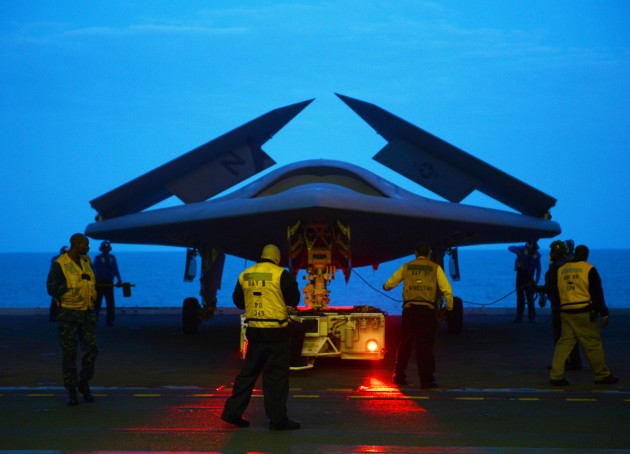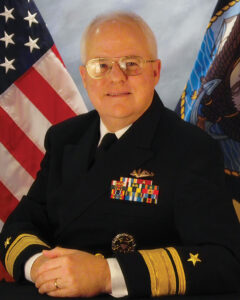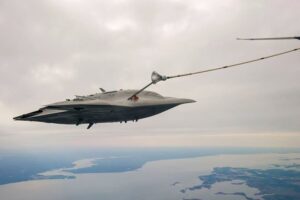Navy Hits Gas On Flying Gas Truck, CBARS: Will It Be Armed?
Posted on

The Navy’s UCAS demonstrator made history as the first drone to take off and land from an aircraft carrier. Its proposed successor was called UCLASS.
WASHINGTON: More gas. Less stealth. Maybe weapons. New name. Same money. Tighter schedule. That, in a dozen words, is how the Navy is evolving its program for carrier-launched drones.
Since the cancellation of the original UCLASS drone– Unmanned Carrier-Launched Aerial Surveillance & Strike — Navy leaders have insisted they would get the simplified successor in service swiftly. That successor is the flying fuel truck now being called the MQ-25 Stingray, a sexier designation for an unsexy aircraft than the bland Pentagon descriptor CBARS, Carrier-Based Aerial Refueling System.

Vice Adm. Joseph Mulloy
Despite the two drones’ very different missions, it’s now clear that the performance requirements for the CBARS scout/tanker are basically a subset, a dumbed-down version, of what was envisaged for the UCLASS scout/bomber. That should allow the Navy to take the acquisition paperwork already approved for UCLASS, revise it lightly, and resubmit it for CBARS, speeding through the normal ponderous process to approve a “new start” program.
Navy programs must normally pass through six gates, for example, though some of these six steps can be combined. For CBARS, the Navy plans to compress the first five into a single meeting, after which it will issue a formal Request For Proposals to industry and an acquisition strategy sometime this summer.
“This system is so far along we’re doing what’s called a ‘Gate 1 through 5,’ (something) we’ve never done before, on the third or fourth of April,” Vice Adm. Joseph Mulloy told reporters yesterday. The schedule’s driven simply by “when I can get CNO (Adm. John Richardson), (Sean) Stackley, and myself in one room at one time,” said Mulloy, who is vice-chief of naval operations for integration of capabilities and resources, i.e. money.
An inter-service Joint Capabilities Board (JCB) assessment will follow the Navy Gate 1-5 approval by a couple of weeks, Mulloy went on. The Office of the Secretary of Defense will have to sign off too, the admiral acknowledged, “but (in effect) they’ve already agreed to the program, because it’s de-scoped off the JROC (Joint Requirements Oversight Council) on the UCLASS stuff. There will have to be some kind of OSD review on that, but when that’ll be, I don’t know.”
Just minutes before, Mulloy had spoken to the annual McAleese/Credit Suisse defense conference. Speed on CBARS is only possible, he made clear, because it builds on the body of its predecessor.
“UCLASS is dead but the money that was appropriated by Congress in that line is still usable,” Mulloy said. “We’ve been to the Congress, we’ve talked to all the lawyers” and gotten approval.
CBARS will largely keep the requirements from CBARS, with some adjustments. “We’ve de-scoped some of the stealth requirements [and] we may expand the fuel requirement,” Mulloy said. “The four competitors that we had for UCLASS are still viable [because] we know all four vendors have air bodies that will meet those requirements.”
That doesn’t meant only those four companies — Boeing, General Atomics, Lockheed Martin, and Northrop Grumman — will be allowed to bid, Mulloy emphasized to the press later. It’s just that their past experience will give them a leg up on new competitors. The less stringent requirements, however, should make a wide range of competitors viable.
“Before it was, ‘hey, if you make it too stealthy, you cut out General Atomics, or this person can’t do it, or that one’s high-end,” Mulloy told reporters. Now, “it’s kind of wide open.”

The experimental X-47B drone plugs into an aerial refueling tanker for the first time.
In addition to tanking, the CBARS will be also capable of Intelligence, Surveillance, and Reconnaissance (ISR) missions, Mulloy said. The Navy envisions it refueling manned aircraft in mid-air before heading off on its own for a long patrol. That way CBARS frees up Super Hornet strike fighters for strike missions rather than “buddy tanking” or reconnaissance roles at which such high-performance machines are inefficient.
This vision is a far cry from the heavy long-range stealth bomber many in Congress and the thinktank world wanted UCLASS to become. That’s a high technological hurdle for another day, once the Navy has some experience with the more modest CBARS under its belt, Mulloy said: “We’ll worry about the super stealth penetrator when we get to the NGAD [project], Next Generation Air Dominance,” sometimes called the “sixth generation” combat aircraft.
Won’t the Hill be angry about abandoning the stealth bomber idea? That’s not the reaction so far, Mulloy told the media: “I’ve seen all four staff directors talking about unmanned vehicles” — the four being the House and Senate Armed Services Committees and the defense Appropriations subcommittees — “and it’s generally been, ‘okay, the Navy’s got a point here.'”
Will the CBARS even be armed? There seemed to be real confusion on this question between the Office of the Secretary of Defense, which initially said no, and the Navy, which spoke of a capability for “limited strike.”
“We were talking past each other with OSD,” Mulloy said. “There was a communications issue.” Unlike the Air Force, when the Navy installs pylons to attach extra fuel tanks, it always makes those pylons dual-purpose, with not only the plumbing of fuel but the electrical connections to control weapons. CBARS will be capable of carrying drop tanks, which means it will have pylons also capable of carrying weapons.
So while there’s no specific plan to arm CBARS, it will be capable of carrying weapons from the outset. (It’s worth noting, though, that any such externally mounted weapon will ruin whatever stealth the aircraft possesses). Any given weapon will have to go through testing before it’s certified as safe for the drone to use, said Mulloy, but “90 percent” of the work will be done.
Subscribe to our newsletter
Promotions, new products and sales. Directly to your inbox.
